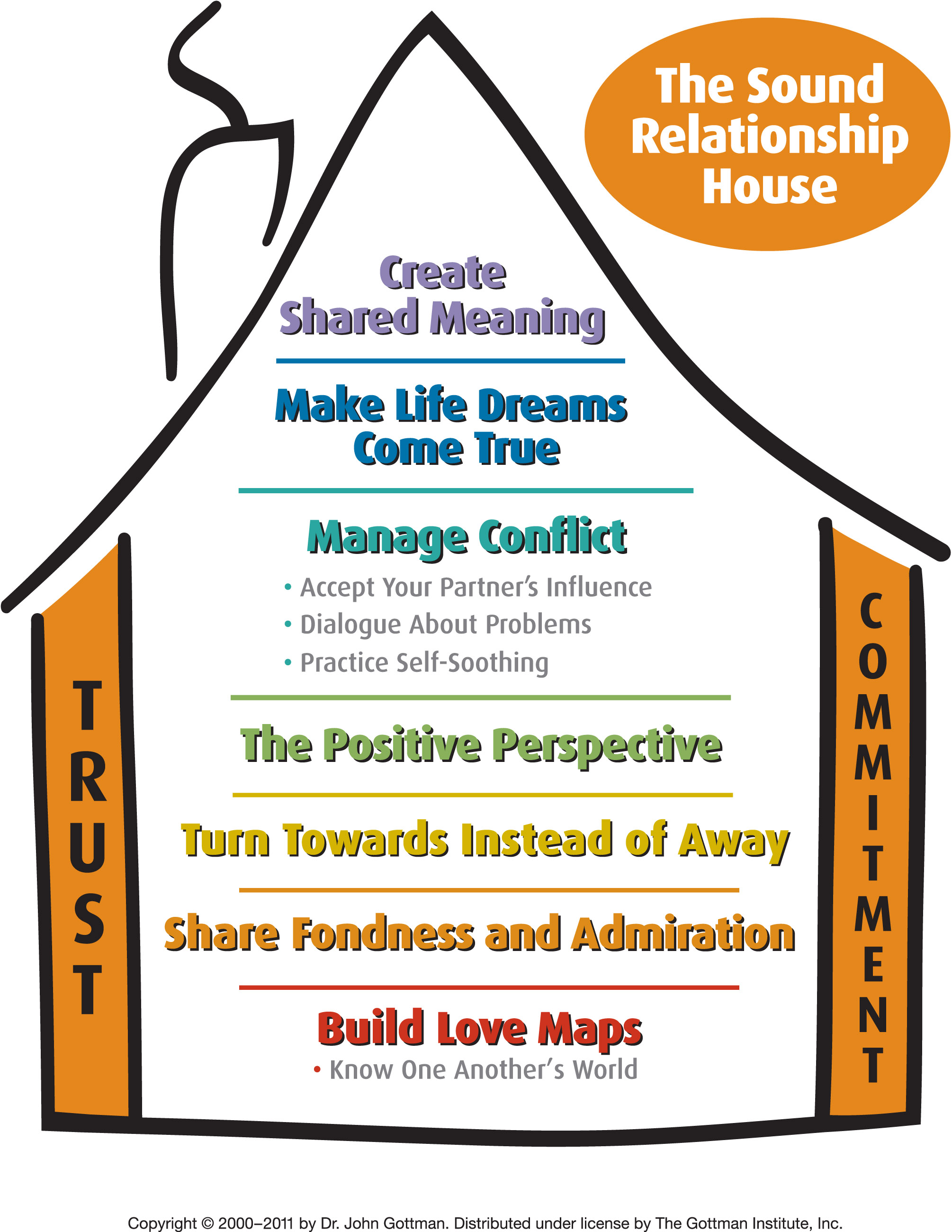The Sound Relationship House theory is the basis of couples work and couples intensive retreats
Adapted from The Gottman Method
There are seven parts of the Sound Relationship House. This is the framework for Gottman couples therapy work. Each of these levels involves building a fundamental process by practicing new skills. The first three levels of the house describe the essential components of your friendship.

2. Share Fondness & Admiration. Make deposits into the Emotional Bank Account of your relationship. This is the antidote for contempt. You do this by changing your habits of mind and learning to behave in moderate and respectful ways with each other. Instead of scanning for your partner’s mistakes, scan for what your partner is doing right and thank them for it. This builds a culture of appreciation, fondness, affection and respect within your relationship.
3. Turn Towards. Accept bids for emotional connection. The small moments of everyday life are actually the building blocks of a relationship. Your partner may either turn toward, turn away, or turn against a bid for connection from you. A bid is a gesture—verbal or nonverbal— for some sort of positive connection: conversation, humor, affection or support. The very small everyday moments in a relationship are opportunities—opportunities for turning toward one another, opportunities that can build the Emotional Bank Account.
4. The Positive Perspective. A positive perspective occurs when the friendship in your relationship is strong. To create this, you need to build your couple friendship by strengthening the first three levels of the Sound Relationship House. This fourth level represents what it feels like in the relationship. Whether it is positive or negative determines the presence of positive attitudes in problem-solving discussions and the success of repair attempts.
5. Manage Conflict. We use the term “managing” conflict rather than “resolving” conflict because relationship conflict is natural and has functional, positive aspects. For example, it helps you learn how to better love and understand your partner, deal with change, and renew courtship and romance over time. You work to manage but not eliminate conflict using six core skills.
- Use a Softened Startup.
- Accept your partner’s influence. Be open to negotiate and compromise
- Discuss your problems. Take turns in listening to one another. Listen to your partner’s underlying feelings and dreams. 69% of couples’ issues are “perpetual problems” due to differences in personalities or lifestyle needs. Learning to dialogue effectively about these problems is the only way to manage your inevitable differences.
- Practice self-soothing. Keeping yourself calm helps calm your partner.
- De-escalate a conflict.
- Repair a conflict within 24 hours.
6. Make Life Dreams and Aspirations Come True. Find ways to support each other’s life goals and dreams. A crucial aspect of any relationship is to create an atmosphere that encourages each person to talk honestly about their dreams, values, convictions and aspirations and to find ways to honor at least some aspect of them. This includes play, fun, and exploration/adventure.
7. Create Shared Meaning. Build a shared sense of purpose. What is your mission and the legacy you wish to leave? This level of the Sound Relationship House is about creating shared meaning by talking about:
- Rituals of connection (formal & informal)
- Shared goals
- Supporting each other’s life roles
- Agreeing about basic symbols such as what home, money, sex and time together/apart mean. Every committed relationship is a cross-cultural experience in which you blend together each partner’s legacy, culture, values, and beliefs to create an entirely new culture. Human beings are meaning-makers and story-tellers, so you need to create a shared story about your life together.
The two walls, Trust and Commitment.
Trust occurs when you believe your partner has your best interest in mind and acts in ways that benefit you. It’s knowing your partner values your interests and needs as much as their own. In other words, knowing that “my partner has my back and is there for me” and learning to work well as a team to support each other.
There are 5 ways to build trust:
- Make being trustworthy a main priority in your relationship. Trust needs to be earned.
- Act to maximize your partner’s well-being.
- Know that trust is built in small, positive moments in your daily interactions.
- Avoid negatively comparing your partner with others.
- Generate frequent thoughts and acts that cherish your partner’s positive qualities. Minimize your focus on their negative qualities. Look for what they’re doing right and thank them for it.
Commitment means believing and behaving as if this relationship is a lifelong journey, for better or for worse. This means that if it gets worse you will both work to improve it. It involves cherishing your partner’s positive qualities and nurturing an attitude of gratitude about what you have with this person. You compare them favorably with real or imagined others, rather than trashing your partner by magnifying their negative qualities and nurturing resentment by making unfavorable comparisons.
During Gottman couples therapy and two day intensives, these seven levels and two walls of the “Sound Relationship House” are our guide. The Gottmans are grateful to more than three thousand couples who, through their participation in their research, gave them the secrets for how to build strong and lasting relationships. It is these skills and strengths that the Gottmans wish to impart to you.
